Analyzing Demand with Respect to Offer of Mobility
Abstract
:1. Introduction
1.1. Related Works
1.2. Paper Aims and Structure
- investigate how the demand is satisfied in terms of public transportation mobility by the offer considering model, simulation tools and KPIs (key performance indicator, e.g., drop-offs and pick-ups at a stop) and related evidence information (e.g., passing lines in every time interval, passing lines in each time interval) with the aim of identifying crowded condition on bus-stops and on the busses.
- Taking care in the model: (i) a range of data sources. People flow depends on different aspects (e.g., the time of day, the motivation of people for travelling, the structure public transportation network, places that with high impacts on mobility patterns). Therefore, using a wide spectrum of data sources related to the city structure (e.g., roads, stop locations), the mobility demand considering different places (e.g., residential areas, shopping centers, stadiums), and the service offer (e.g., the number of vehicle trips and lines passing the stops) supports a deeper analysis of PTSs, and as a result, more precise decisions about mobility policies; (ii) multi-modality. Multiple travel modes which permit to consider different public transportation modalities; (iii) multi-operators. It provides the analysis of the transportation network when there are multiple mobility operators; (iv) KPIs to objectively assess the alternative scenarios and making a (set of) decision(s) to improve the service offer considering the mobility demand.
- perform what-if analysis by analyzing the impact of a (set of) change(s) in Actual Scenario to see their effects in terms of people and matching demand/offer.
2. Data Source and Requirements Analysis
- census data which includes the mobility (and the public transportation means) of residents from/to the city for different purposes (e.g., work, study);
- traffic flow which includes counting (private) vehicles entering or exiting from the city over time which is typically performed on the city border using different methods (e.g., plate number recognition);
- city structure and services attract city users depending on daytime. For example, in the morning, residential areas and public parking spaces can be starting point of trips because the city users usually start from these places to go to work and study places and return in the late afternoon. Likewise, in the afternoon, service providers (e.g., offices, stores, industries, schools, shopping malls, touristic places).
- commuter flows in the city which can be obtained using different data sources (e.g., Wi-Fi, network cellular, mobile applications, PAXCounter);
- commuter flows accessing the city. For example, in cities (e.g., Venezia, Roma, Firenze) that the presence of tourists cannot be neglected compared to others (e.g., workers, students), data that come from cellular [39] or Wi-Fi [38] networks, can help to analyze different aspects (e.g., the number of tourists that are daily present in the city, the duration of their stay, their origin and destination in long term/distance).
- deployed transportation services which can be achieved using different methods (e.g., counting the commuters onboard, waiting at stops/stations, in multimodal hubs, exiting from railway stations over time).
3. DORAM Architecture
- Scenario Production. A new scenario is created by aggregating different kind of data. The Scenario model is formalized in a knowledge base NoSQL RDF Storage with all the city relationships and services are modeled. In particular: (i) to load/change/create a transport offer in the so called static GTFS manager (GTFS) has been used to edit an existing GTFS data feed, (ii) Snap4City OSM2SM tool allowed to retrieve the residential building data from OpenStreetMap (OSM) [40] database and save them in a PostgreSQL database, (iii) census data, which includes different categories (e.g., daily resident flow from each locality to another for work or study, the daily tourist flow), retrieved from various sources (e.g., [41,42]), (iv) Points Of Interest (POI) data, retrieved using ServiceMap of Snap4City [43].
- DORAM Modelling takes the scenario information to define the simulation and relating the data, associated with service offer and the mobility demand, and the simulation output, as described in Section 4.
- DORAM Analyzer performs the analysis of the public transportation system by comparing the mobility demand and service offer. In order to do that, the scenario data are retrieved using ServiceMap APIs calls and SPARQL queries performed on Snap4City/Km4City knowledge base [44] provided for each scenario in a separated Docker (e.g., [41,42]).
- DORAM Front-End allows to (i) select the scenario to be analyzed, (ii) browse the scenario by navigating in the transport offer (bus stops, lines, time schedule, start stops, etc.), (iii) browse the city areas to see the services and point of interests, (iv) analyze the results of each scenario.
4. Model and Analyzer
4.1. Modelling Public Transport Service Offer
4.2. Modelling Mobility Demand
4.3. Service Offer with Respect Mobility Demand Computation
4.3.1. Paper Aims and Structure
4.3.2. Beginning and Final Stops’ Analysis
4.3.3. KPI Analysis
5. DORAM Tool
- Multi-modality: transportation modalities are considered in the model: train, tram, and bus;
- Multi-operativity: It manages the offers of different mobility operators. In the city of Florence, we have 13 main mobility operators (e.g., ATAF, Trenitalia, GEST, etc.). The distribution of their services is not uniform.
- changing the offer and the demand in the scenarios of analysis by creating new scenarios, changing the offer and also the services in the maps, and knowledgebase. More details are reported in Section 6.
- computing KPIs and related evidence information to perform the PTS analysis and provide support for decision makers about mobility policies in the city. The most relevant KPIs include the number pick-ups and drop-offs at a given stop over time. Moreover, nearby POIs (shopping centers, offices, shops, tourist attractions) along with each vehicle line, the number of vehicle lines and trips in each time interval are the examples of provided information to support the scenario analysis.
6. Scenarios Analysis and Results
6.1. Validation of the DORAM Model and Weights
6.2. Alternative Scenario Analysis
7. Conclusions
Author Contributions
Funding
Institutional Review Board Statement
Informed Consent Statement
Data Availability Statement
Acknowledgments
Conflicts of Interest
References
- Afrin, T.; Yodo, N. A Survey of Road Traffic Congestion Measures towards a Sustainable and Resilient Transportation System. Sustainability 2020, 12, 4660. [Google Scholar] [CrossRef]
- Bilotta, S.; Nesi, P. Traffic flow reconstruction by solving indeterminacy on traffic distribution at junctions. Future Gener. Comp. Syst. 2021, 114, 649–660. [Google Scholar] [CrossRef]
- Bellini, P.; Bilotta, S.; Nesi, P.; Paolucci, M.; Soderi, M. Real-Time Traffic Estimation of Unmonitored Roads. In Proceedings of the 2018 IEEE 16th Intl Conf on Dependable, Autonomic and Secure Computing, 16th Intl Conf on Pervasive Intelligence and Computing, 4th Intl Conf on Big Data Intelligence and Computing and Cyber Science and Technology Congress(DASC/PiCom/DataCom/CyberSciTech), Athens, Greece, 12–15 August 2018; pp. 935–942. [Google Scholar] [CrossRef]
- Smit, R.; Ntziachristos, L.; Boulter, P. Validation of road vehicle and traffic emission models—A review and meta-analysis. Atmos. Environ. 2010, 44, 2943–2953. [Google Scholar] [CrossRef]
- Bilotta, S.; Nesi, P. Estimating CO2 Emissions from IoT Traffic Flow Sensors and Reconstruction. Sensors 2022, 22, 3382. [Google Scholar] [CrossRef] [PubMed]
- Kathuria, A.; Parida, M.; Sekhar, C.R. A Review of Service Reliability Measures for Public Transportation Systems. Int. J. Intell. Transp. Syst. Res. 2020, 18, 243–255. [Google Scholar] [CrossRef]
- Chang, J.S. Assessing travel time reliability in transport appraisal. J. Transp. Geogr. 2010, 18, 419–425. [Google Scholar] [CrossRef]
- Agarwal, S.; Diao, M.; Keppo, J.; Sing, T.F. Preferences of public transit commuters: Evidence from smart card data in Singapore. J. Urban Econ. 2020, 120, 103288. [Google Scholar] [CrossRef]
- Static GTFS Manager. Available online: https://static-gtfs-manager.herokuapp.com/ (accessed on 16 October 2020).
- Antunes, H.; Figueiras, P.; Costa, R.; Teixeira, J.; Jardim, R. Analysing Public Transport data through the use of Big Data technologies for urban mobility. In Proceedings of the 2019 International Young Engineers Forum (YEF-ECE), Hong Kong, 27 April 2019; pp. 40–45. [Google Scholar] [CrossRef]
- Widyawan, B.; Putra, D.W.; Kusumawardani, S.S.; Widhiyanto, B.T.Y.; Habibie, F. Big data analytic for estimation of origin-destination matrix in Bus Rapid Transit system. In Proceedings of the 2017 3rd International Conference on Science and Technology—Computer (ICST), Dubai, United Arab Emirates, 27–28 May 2017; pp. 165–170. [Google Scholar] [CrossRef]
- Tanaka, M.T.; Kimata, T.; Arai, T. Estimation of Passenger Origin-Destination Matrices and Efficiency Evaluation of Public Transportation. In Proceedings of the 2016 5th IIAI International Congress on Advanced Applied Informatics (IIAI-AAI), Kumamoto, Japan, 10–14 July 2016; pp. 1146–1150. [Google Scholar] [CrossRef]
- Zapata, L.P.; Flores, M.; Larios, V.; Maciel, R.; Antunez, E.A. Estimation of people flow in public transportation network through the origin-destination problem for the South-Eastern corridor of Quito city in the smart cities context. In Proceedings of the 2019 IEEE International Smart Cities Conference (ISC2), Casablanca, Morocco, 14–17 October 2019; pp. 181–186. [Google Scholar] [CrossRef]
- Abou-Zeid, M.; Fujii, S. Travel satisfaction effects of changes in public transport usage. Transportation 2016, 43, 301–314. [Google Scholar] [CrossRef]
- Van Oort, N.; Brands, T.; de Romph, E. Short term ridership prediction in public transport by processing smart card data. Transp. Res. Rec. 2015, 2535, 105–111. [Google Scholar] [CrossRef]
- Lam, A.Y.S. Combinatorial Auction-Based Pricing for Multi-Tenant Autonomous Vehicle Public Transportation System. IEEE Trans. Intell. Transp. Syst. 2016, 17, 859–869. [Google Scholar] [CrossRef]
- Shang, S.; Guo, D.; Liu, J.; Liu, K. Human Mobility Prediction and Unobstructed Route Planning in Public Transport Networks. In Proceedings of the 2014 IEEE 15th International Conference on Mobile Data Management, Brisbane, Australia, 15–18 July 2014; Volume 2, pp. 43–48. [Google Scholar] [CrossRef]
- Sun, L.; Tirachini, A.; Axhausen, K.W.; Erath, A.; Lee, D.H. Models of bus boarding and alighting dynamics. Transp. Res. Part A Policy Pract. 2014, 69, 447–460. [Google Scholar] [CrossRef]
- Arnone, M.; Delmastro, T.; Giacosa, G.; Paoletti, M.; Villata, P. The Potential of E-ticketing for Public Transport Planning: The Piedmont Region Case Study. Transp. Res. Procedia 2016, 18, 3–10. [Google Scholar] [CrossRef]
- Zhang, J.; Shen, D.; Tu, L.; Zhang, F.; Xu, C.; Wang, Y.; Li, Z. A Real-Time Passenger Flow Estimation and Prediction Method for Urban Bus Transit Systems. IEEE Trans. Intell. Transp. Syst. 2017, 18, 3168–3178. [Google Scholar] [CrossRef]
- Cao, Z.; Ceder, A.; Zhang, S. Real-time schedule adjustments for autonomous public transport vehicles. Transp. Res. C Emer. 2019, 109, 60–78. [Google Scholar] [CrossRef]
- Oviedo, D.; Granada, I.; Perez-Jaramillo, D. Ridesourcing and Travel Demand: Potential Effects of Transportation Network Companies in Bogotá. Sustainability 2020, 12, 1732. [Google Scholar] [CrossRef]
- Niu, H.; Zhou, X. Optimizing urban rail timetable under time-dependent demand and oversaturated conditions. Transp. Res. C Emer. 2013, 36, 212–230. [Google Scholar] [CrossRef]
- Liu, T.; Ceder, A. Analysis of a new public-transport-service concept: Customized bus in China. Transp. Policy 2015, 39, 63–76. [Google Scholar] [CrossRef]
- Liu, R.; Li, S.; Yang, L.; Yin, J. Energy-Efficient Subway Train Scheduling Design with Time-Dependent Demand Based on an Approximate Dynamic Programming Approach. IEEE T. Syst. Man Cy-S 2020, 50, 2475–2490. [Google Scholar] [CrossRef]
- Seaborn, C.; Attanucci, J.; Wilson, N.H.M. Analyzing Multimodal Public Transport Journeys in London with Smart Card Fare Payment Data. Transp. Res. Rec. 2009, 2121, 55–62. [Google Scholar] [CrossRef]
- Castellanos, J.C.; Fruett, F. Embedded system to evaluate the passenger comfort in public transportation based on dynamical vehicle behavior with user’s feedback. Measurement 2014, 47, 442–451. [Google Scholar] [CrossRef]
- Wu, W.; Zheng, Y.; Cao, N.; Zeng, H.; Ni, B.; Qu, H.; Ni, L.M. MobiSeg: Interactive region segmentation using heterogeneous mobility data. In Proceedings of the 2017 IEEE Pacific Visualization Symposium (PacificVis), Seoul, Korea, 18–21 April 2017; pp. 91–100. [Google Scholar] [CrossRef]
- Li, Z.; Hensher, D.A. Performance contributors of bus rapid transit systems: An ordered choice approach. Econ. Anal. Policy vol. 2020, 67, 154–161. [Google Scholar] [CrossRef]
- Horni, A.; Nagel, K.; Axhausen, K.W. The Multi-Agent Transport Simulation MATSim; Ubiquity Press London: London, UK, 2016. [Google Scholar]
- Krajzewicz, D.; Erdmann, J.; Behrisch, M.; Bieker, L. Recent Development and Applications of SUMO—Simulation of Urban Mobility. Int. J. Adv. Syst. Meas. 2012, 3, 128–138. [Google Scholar]
- Smith, L.; Beckman, R.; Baggerly, K. TRANSIMS: Transportation Analysis and Simulation System; Los Alamos National Laboratory: Santa Fe, NM, USA, 1995. [Google Scholar]
- Di Lorenzo, G.; Sbodio, M.L.; Calabrese, F.; Berlingerio, M.; Nair, R.; Pinelli, F. Allaboard: Visual exploration of cellphone mobility data to optimise public transport. IEEE TVCG 2016, 22, 1036–1050. [Google Scholar] [CrossRef]
- MOSAiC Project: Mobility 4.0 for Smart Cities. Available online: https://www.disit.org/drupal/?q=node/7174 (accessed on 5 September 2022).
- Bellini, P.; Benigni, M.; Billero, R.; Nesi, P.; Rauch, N. Km4City ontology building vs. data harvesting and cleaning for smart-city services. J. Vis. Lang. Comput. 2014, 25, 827–839. [Google Scholar] [CrossRef] [Green Version]
- Badii, C.; Bellini, P.; Difino, A.; Nesi, P. Smart City IoT Platform Respecting GDPR Privacy and Security Aspects. IEEE Access 2020, 8, 23601–23623. [Google Scholar] [CrossRef]
- Bellini, E.; Bellini, P.; Cenni, D.; Nesi, P.; Pantaleo, G.; Paoli, I.; Paolucci, M. An IoE and Big Multimedia Data Approach for Urban Transport System Resilience Management in Smart Cities. Sensors 2021, 21, s21020435. [Google Scholar] [CrossRef]
- Bellini, P.; Cenni, D.; Nesi, P.; Paoli, I. Wi-Fi based city users’ behaviour analysis for smart city. J. Vis. Lang. Comput. 2017, 42, 31–45. [Google Scholar] [CrossRef]
- Sohn, K.; Kim, D. Dynamic Origin-Destination Flow Estimation Using Cellular Communication System. IEEE Trans. Veh. Technol. 2008, 57, 2703–2713. [Google Scholar] [CrossRef]
- OpenStreetMap. Available online: www.openstreetmap.org (accessed on 1 April 2019).
- Istituto Nazionale di Statistica. Available online: https://www.istat.it/en/ (accessed on 5 September 2022).
- The Region Tuscany Digital Portal. Available online: http://www.regione.toscana.it/ (accessed on 5 September 2022).
- ServiceMap. Available online: http://servicemap.disit.org/ (accessed on 5 September 2022).
- Nesi, P.; Badii, C.; Bellini, P.; Cenni, D.; Martelli, G.; Paolucci, M. Km4City Smart City API: An Integrated Support for Mobility Services. In Proceedings of the 2016 IEEE International Conference on Smart Computing (SMARTCOMP), St. Louis, MO, USA, 18–20 May 2016; pp. 1–8. [Google Scholar] [CrossRef]
- Overpass Turbo Tool. Available online: http://overpass-turbo.eu/ (accessed on 5 September 2022).
- Tirachini, A.; Hensher, D.A.; Rose, J.M. Crowding in public transport systems: Effects on users, operation and implications for the estimation of demand. Transp. Res. Part A Policy Pract. 2013, 53, 36–52. [Google Scholar] [CrossRef]
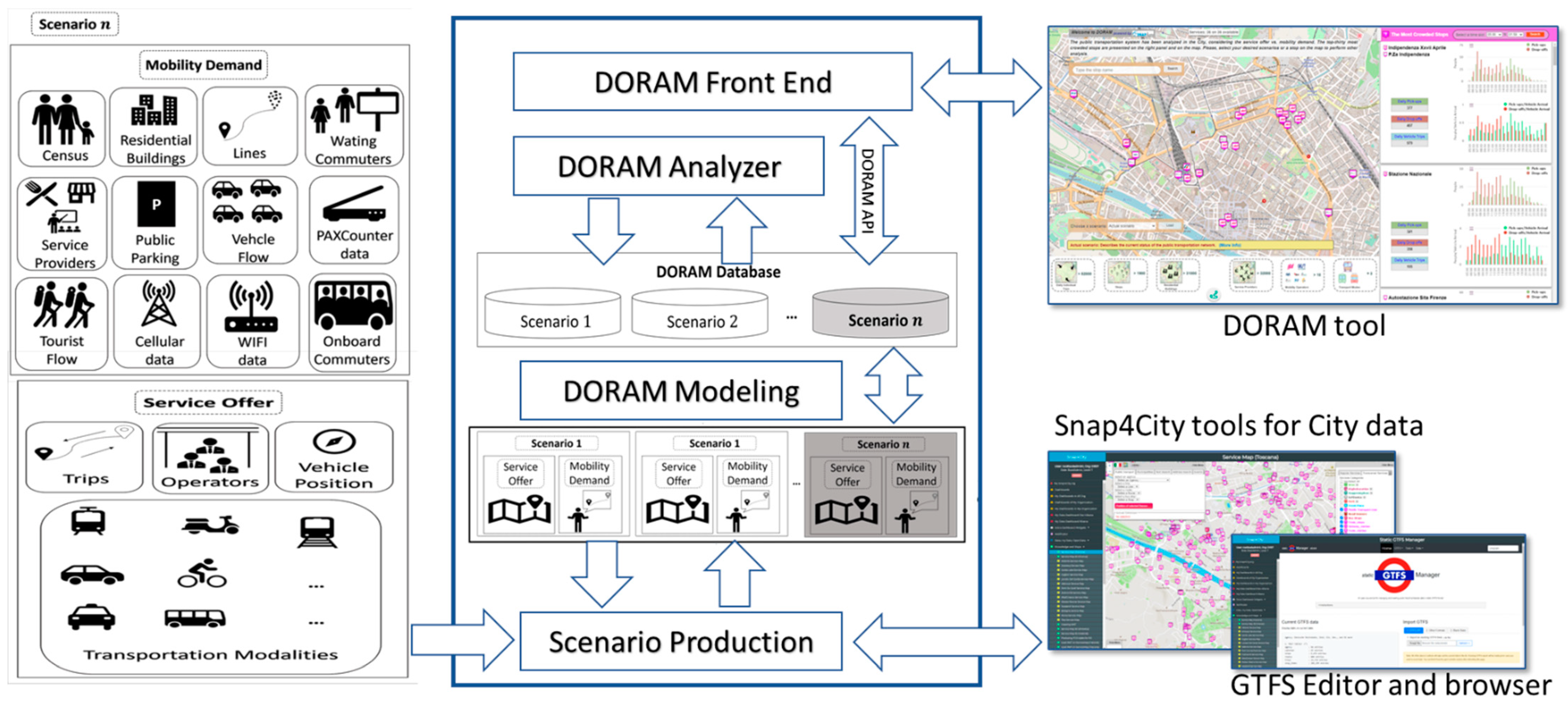



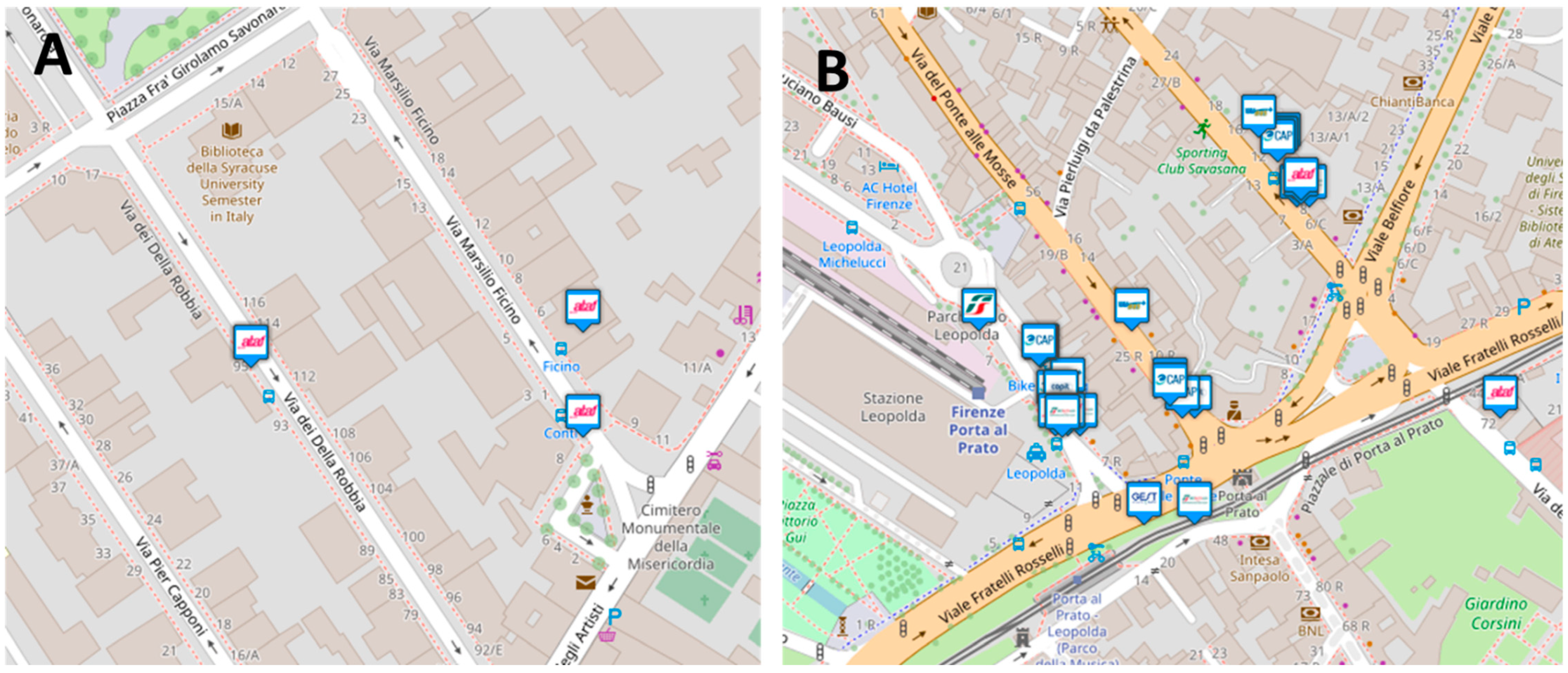
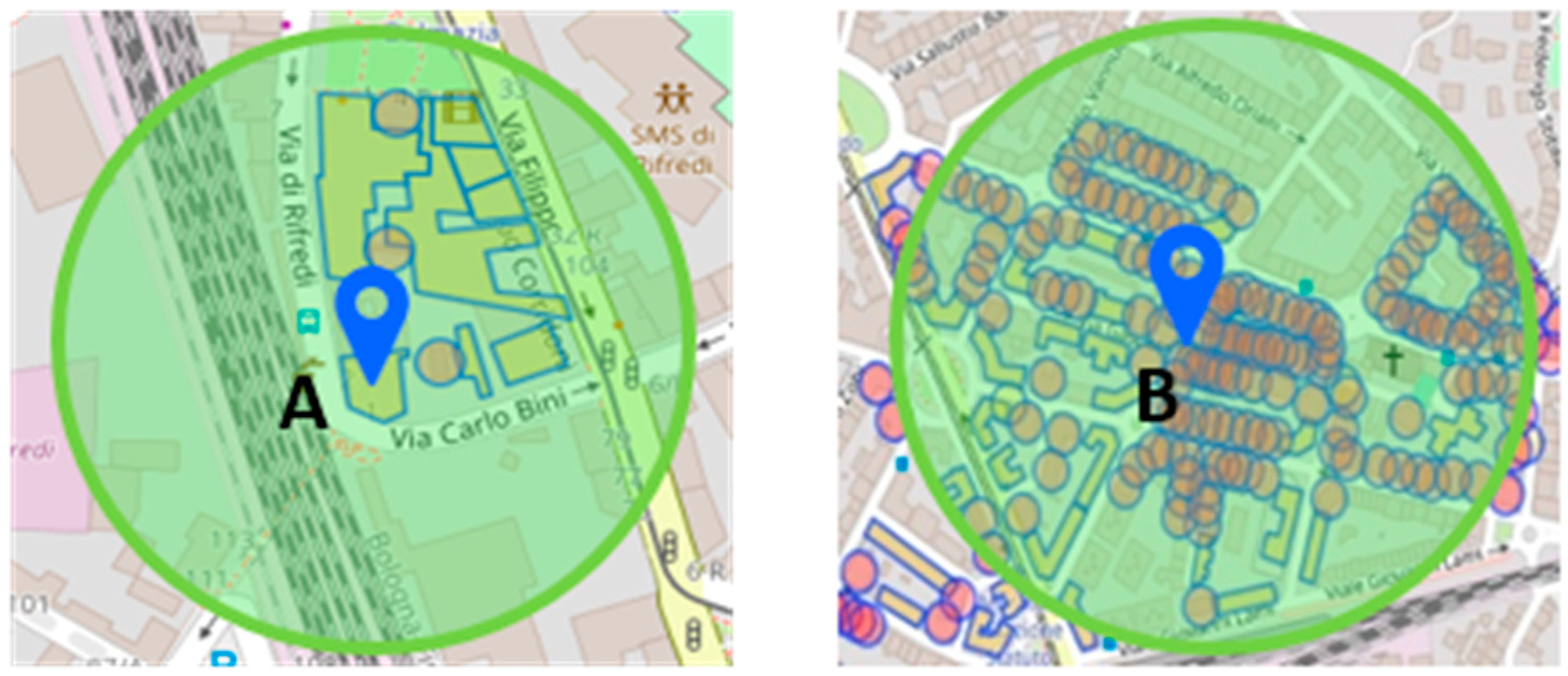

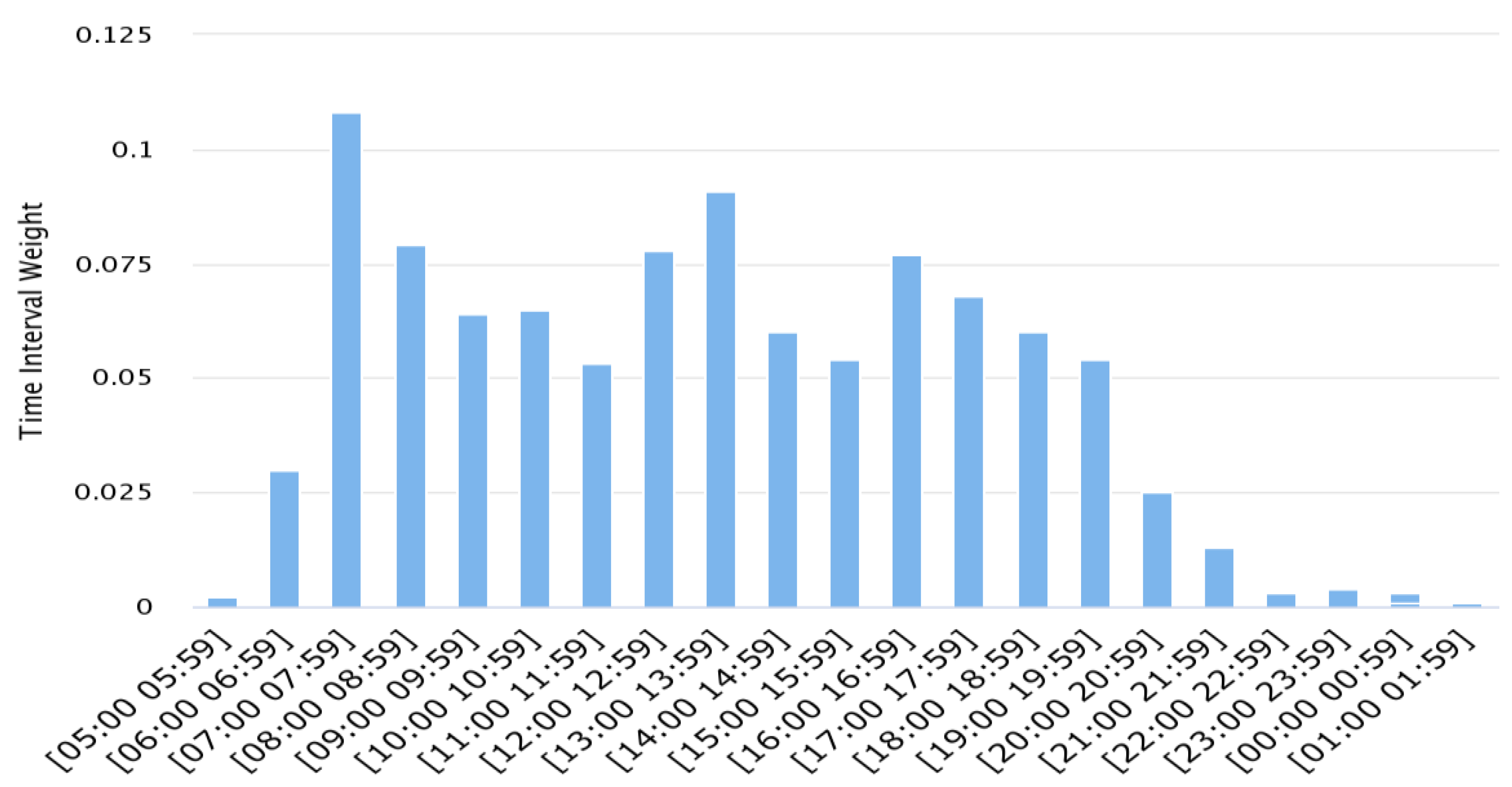

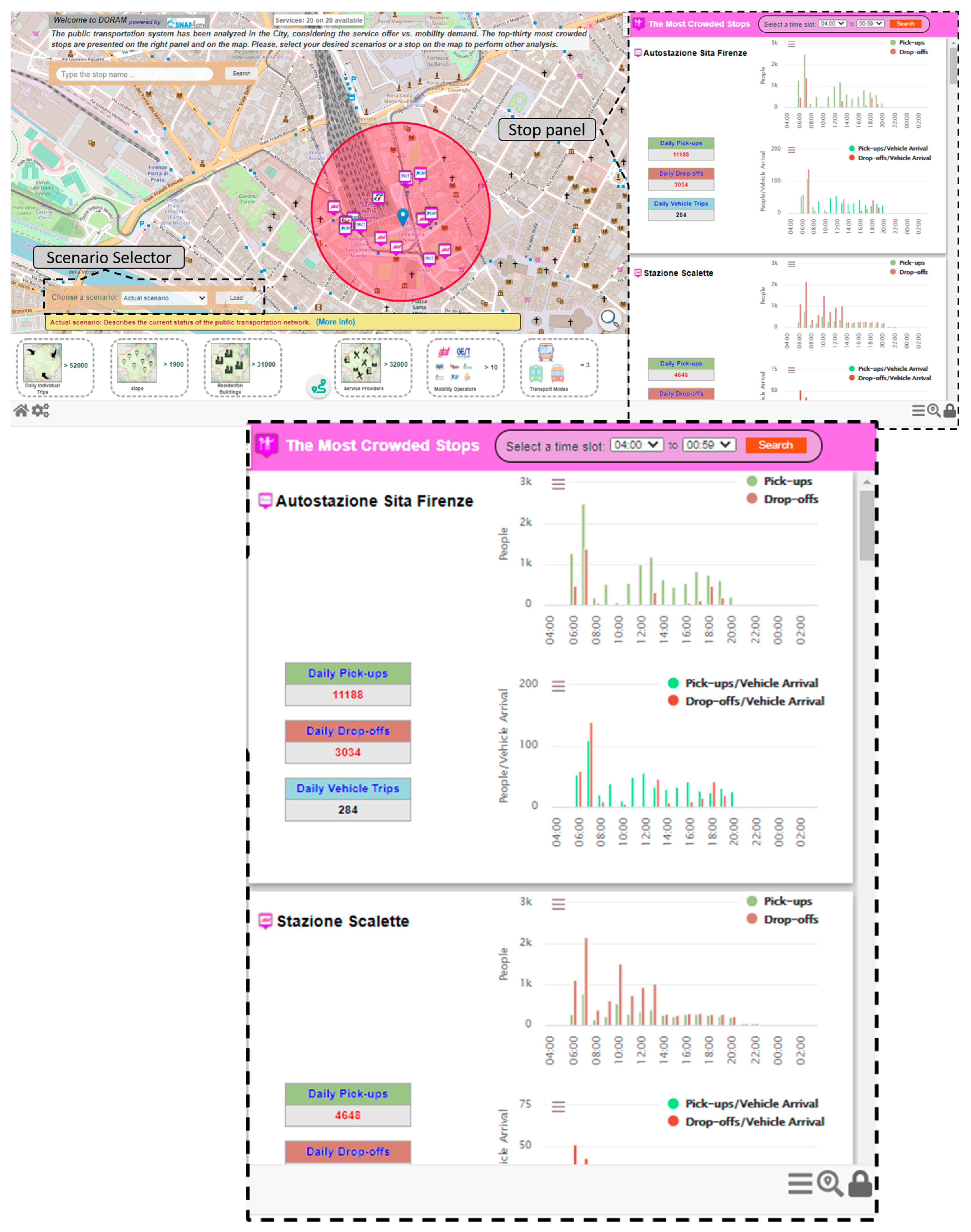
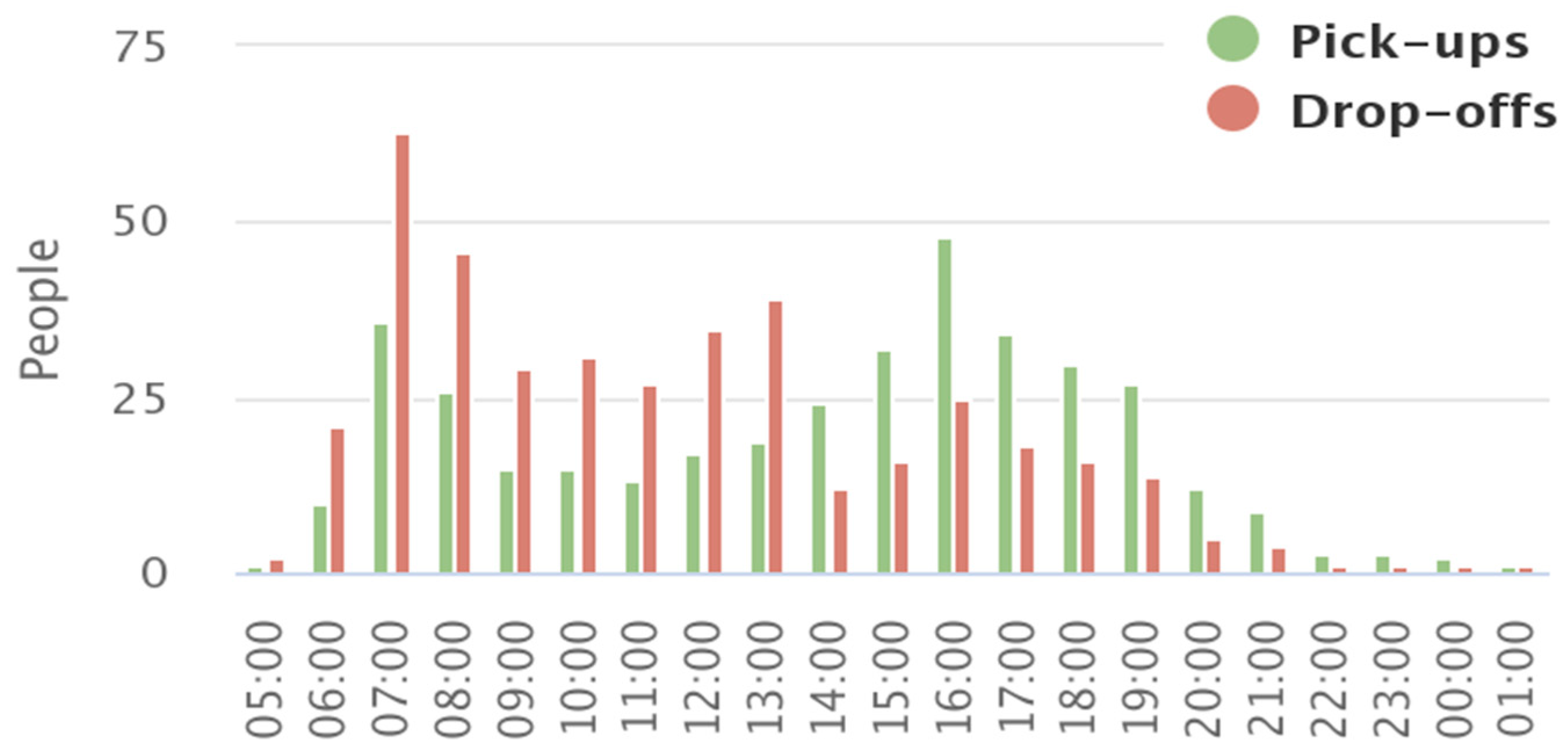
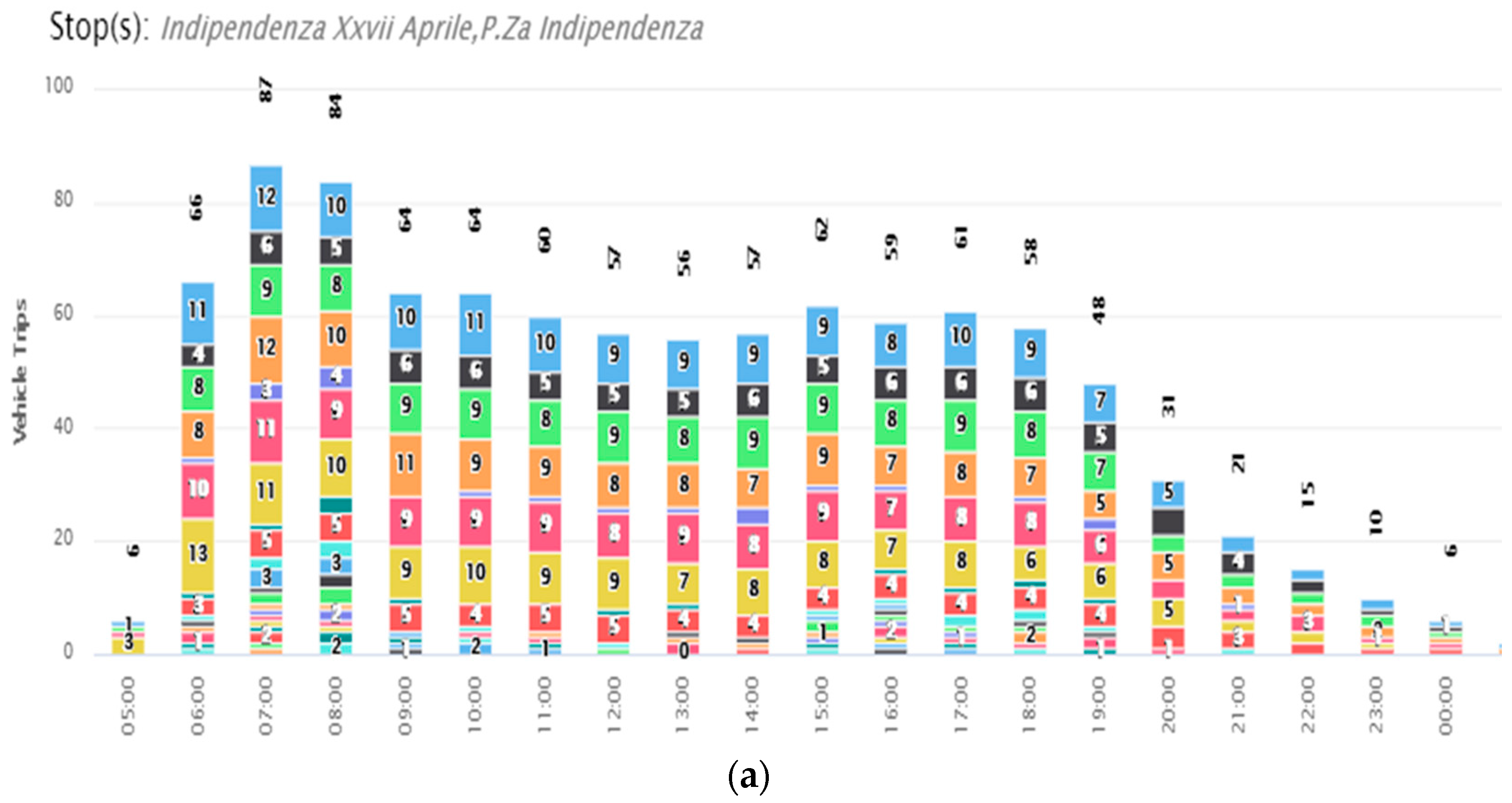

| Selected Tools at the State of the Art | Web-Based Interface That Supports GTFS Data and REST APIs for Analysis Results | Multi-Modal Mobility Application | Multiple Mobility Operators Applications | What-If Analysis Performance |
|---|---|---|---|---|
| DORAM (present work) | Yes | Yes | Yes | Yes |
| MATSim [30] | Yes | Yes | No | No |
| SUMO [31] | No | Yes | No | No |
| TRANSIMS [32] | No | Yes | No | No |
| OmniTRANS [15] | No | Yes | Yes | Yes |
| MobiSeg [28] | No | Yes | Yes | No |
| AllAboard [33] | Yes | Yes | Yes | No |
| Notation | Description |
|---|---|
| A given bus stop | |
| ) | |
| Time set | |
| A given time in | |
| The | |
| Vehicle capacity with modality m and mobility operator | |
| ) | |
| Offer by means ODMs | |
| Demand by means ODMs | |
| Set of locations in the region R | |
| Set of locations in the area A | |
| Number of inbound and outbound individual trips | |
| Beginning, Transfer and Final stops in a commuter trip | |
| Circle with stop s in its center and related radius r | |
| Modality weight vector | |
| pr (parking, residential buildings) weight vector | |
| Service provider weight vector | |
| Stop level of stop s in interval time | |
| Line level of stop s in interval time | |
| pr (parking, residential buildings) level of stop s | |
| Service provider level of stop s | |
| stop weighted sum of stop s in interval time | |
| pr (parking, residential buildings) weighted sum of stop s | |
| Service provider weighted sum of stop s | |
| Probability that stop s is a transfer one by choosing other stops in circle c(s,r) in interval time | |
| Transfer Probability of the stop s by choosing other lines of s in interval time | |
| Transfer Probability of the stop s in interval time | |
| Beginning Probability of the stop s in t ∈ T | |
| Final Probability of the stop s in | |
| Drop-offs and pick-ups at stop s in interval time | |
| Number of vehicle arrivals at stop s in time interval |
| Feature | ATAF Dataset | Florence (Total) |
|---|---|---|
| Service time span | (next day) | (next day) |
| Lines | (21.92%) | |
| Trips | 1173 (16.67%) | |
| Stops | 1513 |
| Parameter | Value |
|---|---|
| Morning time | |
| Afternoon time | (next day) |
| Time interval size | |
| Radius r around stop s | |
| 83,125 | |
| 75,234 |
| Pick-Ups | Drop-Offs | ||
|---|---|---|---|
| Whole ATAF dataset | Max. | 59 | 59 |
| Avg. | 1.27 | 1.27 | |
| RMSE | 2.74 | 2.74 | |
| MAE | 1.44 | ||
| MASE | 0.89 | 0.94 | |
| MSE | −0.8 | −0.7 | |
| Removing 1% of outliers in ATAF dataset | Max. | 10 | 10 |
| Avg. | 1.09 | 1.09 | |
| RMSE | 1.98 | 2.05 | |
| MAE | 1.17 | 1.25 | |
| MASE | 0.91 | 0.97 | |
| MSE | −0.6 | −0.5 |
| Scenario | ActualScen. | Alternative Scenario | ||||
|---|---|---|---|---|---|---|
| Stop | Indipendenza XXVII Aprile | Indipendenza XXVII Aprile | Cosimo Ridolfi | |||
| Mobility Operator | ATAF | Busitalia | ATAF | Busitalia | ATAF | Busitalia |
| Lines | - | |||||
| Daily pick-ups | compared to Actual Scenario) | |||||
| Daily drop-offs | compared to Actual Scenario) | |||||
Publisher’s Note: MDPI stays neutral with regard to jurisdictional claims in published maps and institutional affiliations. |
© 2022 by the authors. Licensee MDPI, Basel, Switzerland. This article is an open access article distributed under the terms and conditions of the Creative Commons Attribution (CC BY) license (https://creativecommons.org/licenses/by/4.0/).
Share and Cite
Arman, A.; Badii, C.; Bellini, P.; Bilotta, S.; Nesi, P.; Paolucci, M. Analyzing Demand with Respect to Offer of Mobility. Appl. Sci. 2022, 12, 8982. https://doi.org/10.3390/app12188982
Arman A, Badii C, Bellini P, Bilotta S, Nesi P, Paolucci M. Analyzing Demand with Respect to Offer of Mobility. Applied Sciences. 2022; 12(18):8982. https://doi.org/10.3390/app12188982
Chicago/Turabian StyleArman, Ala, Claudio Badii, Pierfrancesco Bellini, Stefano Bilotta, Paolo Nesi, and Michela Paolucci. 2022. "Analyzing Demand with Respect to Offer of Mobility" Applied Sciences 12, no. 18: 8982. https://doi.org/10.3390/app12188982





